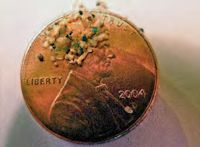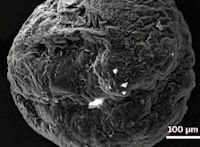SEJournal Online is the digital news magazine of the Society of Environmental Journalists. Learn more about SEJournal Online, including submission, subscription and advertising information.
Inside Story
Award Winner Makes Technical Training a Strength in Uncovering Sources, Stories
 |
 |
 |
| Using fine mesh nets, researchers skimmed the surfaces of the Great Lakes in 2012 and 2013 for tiny bits of plastic known as microbeads. | Microbeads are so small, that it takes dozens of them to cover the head of Abraham Lincoln on a penny. | The weathering of a microbead from its time in the Great Lakes shows up clearly in this scanning electron micrograph. Photos: Courtesy 5 Gyres Institute. |
Chemical & Engineering News’ Cheryl Hogue recently won first place in SEJ’s 13th annual awards for outstanding beat reporting small market, for stories including how microbeads in personal care products impact the environment and how the Small Business Association has become a mouthpiece for industry on chemical issues. Hogue, the magazine’s assistant managing editor for government & policy, with a background in science and policy, has worked at the American Chemistry Society weekly publication since 1999, where she has reported on a wide range of subjects from climate change to the regulation of commercial chemicals. Judges cited her for her “clear, direct writing” in stories that “give readers important insight.” Hogue spoke to SEJournal’s “Inside Story” editor Beth Daley about her work.
SEJournal: Many subjects you cover are new issues that other media outlets later pick up on, such as microbeads and a story on toxic tort cases. Where do you find your ideas?
Cheryl Hogue: I track environmental policies across the UnitedStates by reading news aggregators such as Above The Fold, or tracking Safer States’ database of state legislation on chemicals (www.saferstates.com). I’ve spotted trends emerging, like the city bans on plastic foam food containers. Some ideas come when I get out of the office and mingle with sources – and meet new ones – before or after a congressional hearing or at EPA public meetings.
SEJournal: Your educational background is in science and policy. How important do you think such specialty degrees are to journalism?
Hogue: When I started my professional career fresh out of college, many editors saw my undergraduate degree in biology as a liability, not a strength. They were expecting journalism or English majors to apply for their positions and questioned why I was applying for a reporting job, despite my four years of experience writing for the student newspaper. I struggled with chemistry for two years, yet completing that coursework helped get me two jobs and entry into graduate school for environmental science. Because of my academic background, I’ve been able to effectively interview and understand scientists – academic, industry, and government –from a broad swath of disciplines related to the environment.
Regardless of their degrees, journalists need to be numerate, not just literate. Years ago, I used to calculate percentage changes for several fellow reporters at a newspaper, which was scary because no editor was checking my results. I took a statistics course at a local community college and we read a thin little book called “How to Lie with Statistics” that has helped me ferret out a boatload of B.S. in Washington.
SEJournal: Your writing is incredibly straightforward and fair. How do you keep bias out of your reporting and what is the response to your articles from the chemical and laboratory industry?
Hogue: Keeping bias out of reporting is basic due diligence for old-school journalists: we check out the claims that sources make and follow the money. Someone will be making or losing money with every environmental policy decision – and we need to tell our audience who has skin in the game. I write for an audience of scientists who are extremely picky about how facts are presented and will call us on anything they think leans too far in favor of environmentalists or industry.
SEJournal: Your stories are exhaustively reported and often on dense material, but they are very readable. Do you have any rules of thumb to keep stories simple?
Hogue: Write short declarative sentences. Use the active voice. Seek out jazzy verbs and memorable comparisons – but accuracy trumps everything else. Give technical information in small chunks at a time. Keep the story short.
SEJournal: What was the hardest story for you to get and why?
Hogue: The story on Congress changing how EPA gets its science advice took a lot of digging. So many times politicians simply call witnesses who share their political agenda to testify at hearings, disregarding other sources who could give a more measured response or an alternative view. Knowing who the other knowledgeable sources are is not immediately apparent – many scientists steer clear of politics, especially the highly partisan kind practiced on Capitol Hill nowadays. Unlike the leaders in Congress, I gave a voice to those who actually served on the EPA Science Advisory Board, which I’ve covered on and off for 25 years.
SEJournal: How did you dig deeper into the microbead story?
Hogue: One early story in another publication about microbeads mentioned a professor at the State University of New York in passing. I looked her up and found she was a chemistry professor – a gig my audience relates to. I interviewed her four or six times, in part because the research hasn’t been published yet and I had no source document to reference to get the technical details right. I asked her who else I should talk to and she led me to others working on the microbead issues.
She also mentioned she was doing further work checking for microbeads in sewage plant effluent – yet one company using microbeads had claimed that wastewater treatment plants remove these plastic bits. So I called the National Association of Clean Water Agencies, which represents publicly owned treatment plants, for their view. My source there wasn’t aware – until I told him – that consumer products that are designed to be washed down the drain contain tiny plastic spheres. Sewage plants weren’t designed to remove microbeads – which is actionable information for my audience.
Some of my readers actually help develop personal care products and they might now bring up the issue of sewage plant treatability when companies consider new ingredients. Plus, most readers use toothpaste or facial washes and some might decide not to use products with microbeads.
SEJournal: What advice would you give to a young journalist starting out?
Hogue: Keep asking questions until you understand whatever it is you are reporting on. And strengthen your numeracy. You don’t need calculus but build confidence in doing basic calculations.
“Inside Story” editor Beth Daley is a reporter and director of partnerships at the New England Center for Investigative Reporting, a nonprofit newsroom based at Boston University and affiliated with WGBH News.
* From the quarterly newsletter SEJournal, Fall 2014. Each new issue of SEJournal is available to members and subscribers only; find subscription information here or learn how to join SEJ. Past issues are archived for the public here.












 Advertisement
Advertisement 



